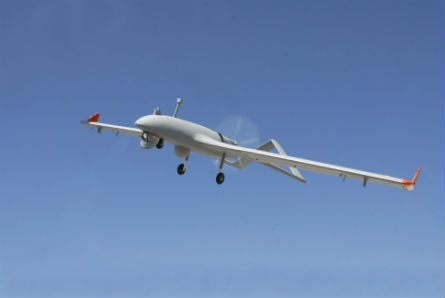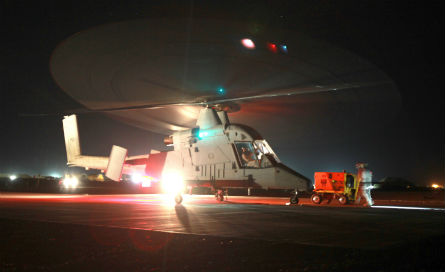Barriers to entry into the industrial base at any level for the US Department of Defense (DoD) are steep, but nowhere more so than in the highest level of aircraft manufacturing.
It is one thing to join the ranks of component suppliers, but quite another to reach the exalted status of prime contractor of a military aircraft. In the US market for fixed-wing, manned military aircraft, there are generally only three options: Boeing, Lockheed Martin and, to a lesser degree, Northrop Grumman.
For two decades, the sector of unmanned air vehicles (UAVs) has proved the rare exception, injecting a level of competition and innovation not seen in the market for manned military aircraft in several decades.
While the three major aircraft primes have won or acquired a significant share of UAV contracts, new entrants have often challenged, and occasionally won against, the primes for a seat at the prime contractor table.
General Atomics Aeronautical Systems and AeroVironment, for instance, have catapulted from small to mid-tier suppliers to prime contractors responsible for designing and integrating complete systems, including air vehicle, systems, payloads and ground control station.
Still other firms, including Insitu and AAI, have transformed small investments made nearly two decades ago into now ubiquitous UAV platforms.
As a result, both companies fashioned themselves into acquisition targets for larger primes. Now, Insitu has been preserved as a standalone entity within Boeing and AAI as a key division within the Textron Systems unit.
Meanwhile, General Atomics' UAV division and AeroVironment continue to compete as autonomous companies.
Few other sectors in the aircraft industry can boast such recent success for accepting new entrants. Even in the market segment for commercial aircraft, Richard Aboulafia, vice-president of analysis at the Teal Group, has concluded that no new entrant has survived since the arrival of Embraer in the 1960s.
At the same time, however, the competitiveness of the UAV sector can be overstated. The DoD only began opening the largest contracts to competition in 2004. Moreover, lurking in the shadow cast by the success of these four new entrants is a harsher reality.
The next wave of prospective new entrants as prime contractors for UAV "programmes of record" - a term of art in military acquisition denoting a contract with firm requirements for long-term output and sustainment − may find few, if any opportunities in the decade ahead.
"This is not the situation a decade ago where smaller companies had the potential to make it big in the UAS [unmanned aircraft systems] industry," says Philip Finnegan, director of corporate analysis at the Teal Group.
One reason for the lack of opportunity is the US defence budget, which is primed to enter a spending downcycle expected to persist for several years. As budgets constrict, even the sectors most in demand, which would include UAVs, are likely to feel the pinch.
Seemingly at odds with the budget trend is the operational commanders' demand for the services provided by UAVs, which is dominated by the mission area for intelligence, surveillance, reconnaissance (ISR) and target acquisition. As the Afghanistan mission winds down, the US Air Force is projecting the need for more sorties by its General Atomics MQ-9 Reaper squadrons, says Ron Stearns, a research director for the Seattle-based G2 Solutions consultancy.
The effect on the industrial base is that more dollars will be devoted to operations and maintenance accounts, at the expense of investment in the new capabilities that offer opportunities to the next wave of new entrants.
"There is less and less money announced for smaller [UAV] companies," Stearns says.
Another factor changing the UAV industrial landscape is a strategic shift by the DoD from irregular to conventional threats.
Facing the non-traditional opponents of the past decade, the DoD was more open to seeking solutions from non-traditional suppliers. That attitude is changing, with a renewed emphasis on conventional capabilities, such as survivability and access to denied airspace.
"I see the pendulum swinging back violently and quickly to more of a conventional acquisition paradigm," Stearns says.
UAV contracts are awarded in two broad categories. The first of these is a programme of record, and the other is a rapid reaction or one-off demonstration contract.
Programmes of record in the fixed-wing military UAV sector have divided into five tiers, each now with an established supplier to the DoD.
Each represents a programme that has matured past the point of demonstration and experimentation, with millions or billions budgeted for production and sustainment.
"The potential for large and small companies to radically change their position is really quite limited in this environment," says Finnegan.
At the top of the list, in terms of dollar value, is the Northrop RQ-4B Global Hawk and MQ-4C Triton. Below that level is the family of General Atomics UAVs for the medium-altitude mission, which include the MQ-9 Reaper and MQ-1C Gray Eagle.
AAI has locked up the programmes of record for a brigade-level UAV with the RQ-7 Shadow. Boeing Insitu's ScanEagle helped define the requirement for a small tactical UAS, and the company owns the replacement contract for the RQ-21A Integrator.
 |
|---|
| AAI AAI has unveiled an improved M2 version of the ubiquitous RQ-7 Shadow |
AeroVironment's family of hand-launched UAVs, led by the RQ-11 Raven, dominates the programme of record for the lowest tier.
In each of these categories, there still remain challengers seeking to win a share of the market or replace the incumbent entirely.
The candidates typically promise a radical increase in capability, whether it is the hand-launched Lockheed Stalker powered by laser energy or the high-altitude Boeing Phantom Eye using liquid hydrogen as fuel. Such challengers have pushed the incumbents to respond by investing in capability improvements for the existing platforms.
"In a time when there aren't going to be new programmes, the focus is going to be on retaining what you have and upgrading it," Finnegan says. "The established players really have a strong advantage."
More opportunity for disruption exists in the UAV sectors and mission areas that have not fully matured.
Northrop's MQ-8B Fire Scout pioneered the role of a vertical take-off and landing (VTOL) UAS, particularly for the ISR mission.
The appetite for unmanned VTOL capability appears to be growing, with Northrop teaming with Bell Helicopter to offer a modified 407 as the MQ-8C.
As a larger aircraft, it will be capable of growing into new roles, such as autonomous cargo delivery, but it will not be alone.
"The VTOL sector is kind of where the whole UAV market was prior to 2001," says Larry Dickerson, an analyst with Forecast International.
Challenging the MQ-8C are new entrants including a Kaman/Lockheed team demonstrating an unmanned version of the K-Max helicopter in Afghanistan and the Boeing A160 Hummingbird, which the prime contractor acquired from Frontier Systems, and which was founded by Abe Karem − the inventor of the Predator.
 |
|---|
| US Marine Corps An unmanned version of the K-Max is being assembled in Afghanistan |
In both cases, the "new entrant" represents established, traditional DoD prime contractors for rotorcraft and other types of aircraft. The same dynamic is likely to re-emerge with the US Navy's requirement for an unmanned carrier-launched aircraft for surveillance and strike, where the competitors include Boeing, General Atomics, Lockheed and Northrop.
Source: Flight International
















